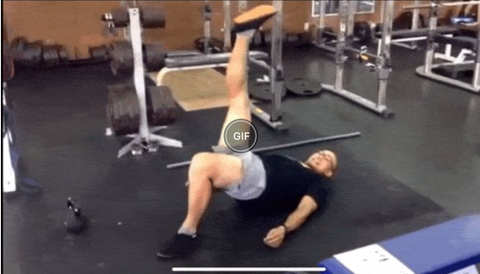In addition, the glute bridge is also a good warm-up exercise before training, which can maximize the function of the gluteal muscle as a hip extensor group.
For example, athletes with lower back pain often recruit more of their lower back and hamstrings than their glutes when doing deadlifts
If you do the glute bridge activation first in the warm-up, you can improve this compensatory problem very well.
The movement introduced to you today is to make some changes on the basis of the traditional hip bridge, and to increase the rotation function of the hip joint and trunk on the premise of ensuring the stability of the lumbar spine. Many times our lower back pain is due to the replacement of the lumbar spine. This ability can go a long way in preventing low back pain because it compensates for excessive exercise.
Rotating Hip Bridge

This exercise is based on the traditional hip bridge training action, with one leg supported, the other leg is lifted and stretched, and gradually rotated to the outside, paying attention to the premise of ensuring full control and maintaining the body position Increase the range of rotation to further strengthen the control of the abdominal muscles on the lumbar spine, improve the rotational stability of the hip joint, and avoid the rotation of the lumbar spine.
Why You Should Avoid Lumbar Rotation
One of the main sources of lower back pain is the excessive rotation of the lumbar spine. Runners need to avoid lumbar spine rotation when stepping forward. Golfers need to increase the range of motion through thoracic spine rotation while maintaining lower back stability. (reduces lumbar rotation).

Excessive movement occurs in the lower back when the hip joints or thoracic spine lose mobility. Mike Boyle, a famous strength and conditioning coach, said before: "Over the past ten years, the biggest mistake we have made in training is to over-increase static stability and active range of motion in areas that need stabilization. There are many rotation exercises for the lumbar spine in particular, many of which are incorrect. correct."
Physical therapist Shirley Sahrmann explains in Diagnosis and Treatment of Dyskinesia Syndromes: "Excessively increasing the range of motion of the lumbar spine is not recommended because of the potential risks involved." We lack thoracic spine mobility and thus This leads us to try to increase the rotational range of motion of the lumbar spine, which is a huge mistake. "
![[Functional Training] This action can improve rotational stability and prevent lower back pain](http://zenopax.com/cdn/shop/articles/YTFA4U9R41Q4V0Y8BYF_JNS.jpg?v=1685168904&width=2500)

